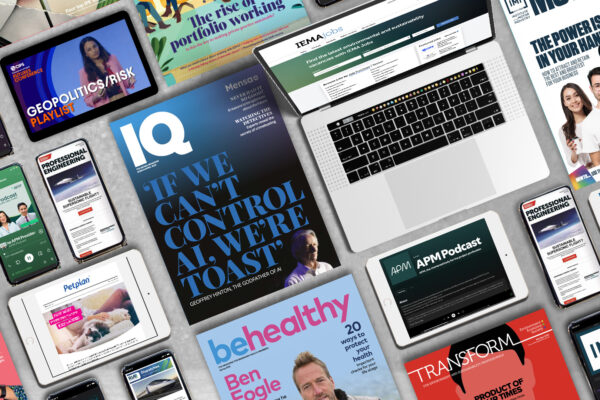Newsletters remain one of the most powerful tools for member engagement, delivering curated content directly to members. But what truly makes a newsletter stand out?
At Think’s recent masterclass webinar, we talked to two leading email experts: Chris Giles, award-winning writer of the Financial Times newsletter Chris Giles on Central Banks, and Richard Headland, publishing consultant and former Editor-in-Chief at Which?
Together, they shared the following invaluable insights on proven ways to create a successful newsletter:
-
The essential ingredients of a great newsletter
Quality is non-negotiable. Strong editorial judgement, clear design and consistent delivery form the backbone of an effective newsletter.
• Clarity of purpose: Readers should immediately understand the value your newsletter provides – whether that’s expert analysis, community updates or practical advice.
• Readable design: Keep layouts clean and scannable. A modular, templated structure provides familiarity while allowing space for variety.
• Voice and personality: A newsletter isn’t just another article – it’s a conversation. Chris emphasised the importance of a more personal tone, differentiating newsletters from traditional reports.
-
Using data to shape content
Insight into how your audience interacts with content can transform a newsletter’s performance. Don’t be afraid to experiment with formats, from interviews to data visualisations, to see what drives engagement. Regular analysis can help your team pivot quickly and avoid stagnation. Key metrics to measure are:
• Click-through rates (aiming for around 10% as a healthy benchmark)
• Unsubscribe rates, which signal whether content is resonating
• A/B testing, particularly of subject lines, to maximise open rates
-
Finding the right frequency
How often should you hit ‘Send’? There’s no one-size-fits-all answer, but consistency is key. Members are more likely to stay engaged if they know when to expect your updates.
• Weekly newsletters offer a good balance between timeliness and depth, ensuring readers know when to expect updates.
• For organisations with multiple audience groups, a suite of topic-specific newsletters – each with different frequencies – can work well. This was the approach that helped the FT grow its newsletter subscribers from 1,000 to nearly three million in just three years.
-
Personalisation builds loyalty
Members respond positively when content feels directly relevant to them, although hyper-personalisation can risk limiting discovery of unexpected yet valuable content. Striking the right balance is key. The right level of personalisation could include:
• Using names and tailored intros to foster a conversational tone
• Highlighting content based on reader preferences, such as professional role or membership tier
• Providing exclusive access to editors, executives or behind-the-scenes insights
-
Lead with irresistible hooks
First impressions matter. Subject lines and opening lines are your chance to stand out in a crowded inbox. There is also power in curiosity and exclusivity: framing content as “new research”, “behind-the-scenes insight”, or a “best-of” round-up makes it feel both valuable and timely. This could include:
• Subject lines that highlight a benefit (“Save time with these three quick fixes”)
• Headlines that promise exclusivity (“What only our members know about…”)
• Urgency or timeliness (“Don’t miss this week’s update on…”)
-
Encourage feedback and interaction
A newsletter doesn’t need to be one-way communication. Including elements that actively invite a response – simple tools such as embedded polls, “reply to share your views”, or surveys – can give members a voice and build a sense of community. Examples include:
• Polls or rating buttons on articles (“Was this useful?”)
• Invitations to reply with opinions or questions
• Short surveys about member needs or preferences
• Prompts for content ideas (“Tell us what you’d like covered next”)
• Links to online forums or discussion groups
-
Mix content formats for variety
A wall of text can be offputting, but mixing formats keeps readers engaged. The FT newsletter often combines charts, interviews and commentary to tell a richer story. For membership organisations, variety shows members you value their time and attention. This could include:
• Short news updates alongside a longer feature
• Infographics or data visualisations to simplify complex topics
• “Member spotlight” profiles or interviews
• Quick Q&As or top-five lists for easy scanning
• Event highlights, podcasts or video snippets embedded in the email
-
Build a sense of community
Beyond content, newsletters should help members feel part of something bigger. Richard stressed the value of offering exclusive touches that deepen loyalty. Over time, the newsletter can evolve into a genuine membership benefit. Examples include:
• Early access to events, webinars or resources
• Invitations to member-only forums, Q&As or networking sessions
• Recognition features (“Congratulations to our newest fellows”)
• Behind-the-scenes updates from leaders or guest contributors
• Opportunities for members to contribute stories or case studies
A successful membership newsletter is more than a broadcast – it’s a relationship. By combining clear purpose, smart use of data, consistent delivery and thoughtful personalisation, organisations can transform newsletters into indispensable membership benefits.
As Richard put it, the goal is not just to inform but to create a community of readers who feel valued, engaged and loyal. For Chris, the success of his FT newsletter lies in speaking directly to subscribers in a personal, authentic voice.
Feeling inspired? Get in touch with our brilliant new business team today to find out how Think can help supercharge your email newsletter offering.





